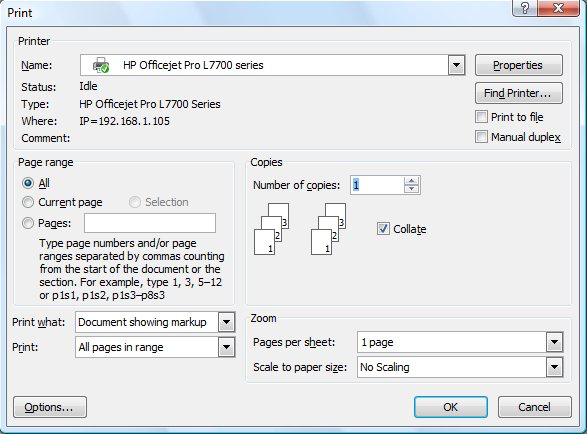Please Note: This article is written for users of the following Microsoft Word versions: 2007, 2010, 2013, 2016, 2019, 2021, and Word in Microsoft 365. If you are using an earlier version (Word 2003 or earlier), this tip may not work for you. For a version of this tip written specifically for earlier versions of Word, click here: Scaling Your Output.
Written by Allen Wyatt (last updated July 1, 2023)
This tip applies to Word 2007, 2010, 2013, 2016, 2019, 2021, and Word in Microsoft 365
You have been working on your document for hours. It is 35 pages long, and designed to be printed on legal-size paper. You decide to print the document, and discover you are out of legal paper. What do you do if you can't get any legal paper right away? You could reformat the document for letter-size paper, but that may not be the best solution.
Fortunately, Word includes a feature that allows you to independently specify a target paper size and an output paper size. This means you can format something for legal size, but instruct Word to scale the output so it will fit on letter size. This is very similar to a reduction setting on a copier. To take advantage of this feature, follow these steps:
If you are still using Word 2007, then the steps are different:

Figure 1. The Print dialog box.
WordTips is your source for cost-effective Microsoft Word training. (Microsoft Word is the most popular word processing software in the world.) This tip (10936) applies to Microsoft Word 2007, 2010, 2013, 2016, 2019, 2021, and Word in Microsoft 365. You can find a version of this tip for the older menu interface of Word here: Scaling Your Output.

Learning Made Easy! Quickly teach yourself how to format, publish, and share your content using Word 2021 or Microsoft 365. With Step by Step, you set the pace, building and practicing the skills you need, just when you need them! Check out Microsoft Word Step by Step today!
Need to add a unique serial number to each printed copy of your document? Here's a quick way to print such numbered versions.
Discover MoreWord allows you to take full advantage of the capabilities of your printer. Accessing those capabilities is done through ...
Discover MoreDo you need a printout where graphics can be turned on and off? This tip provides some concrete ways you can get just ...
Discover MoreFREE SERVICE: Get tips like this every week in WordTips, a free productivity newsletter. Enter your address and click "Subscribe."
There are currently no comments for this tip. (Be the first to leave your comment—just use the simple form above!)
Got a version of Word that uses the ribbon interface (Word 2007 or later)? This site is for you! If you use an earlier version of Word, visit our WordTips site focusing on the menu interface.
Visit the WordTips channel on YouTube
FREE SERVICE: Get tips like this every week in WordTips, a free productivity newsletter. Enter your address and click "Subscribe."
Copyright © 2026 Sharon Parq Associates, Inc.
Comments